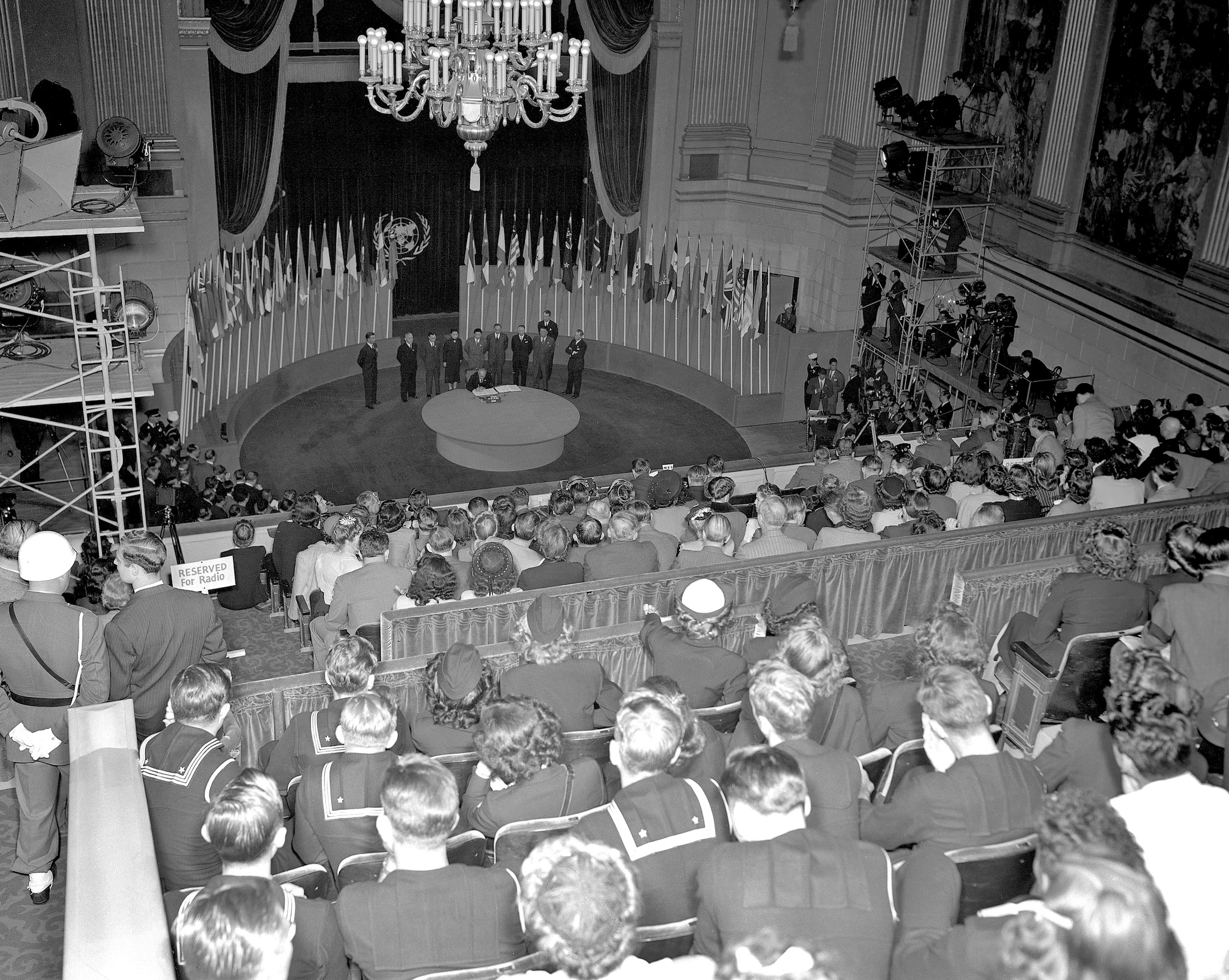
The UN Charter

Today the United Nations employs more than 40,000 people, has a biennial budget of more than 5 billion USD, and works with 15 specialized agencies, 11 Funds and Programmes and 16 active peacekeeping missions. But whether it is helping to improve gender equality, providing humanitarian aid or assisting in the rebuilding of war-ravaged nations, all of the good the United Nations does today began with the UN Charter.
History of the UN Charter
The UN Charter and its history began with the Atlantic Charter, a joint declaration between American President Franklin Roosevelt and British Prime Minister Winston Churchill affirming, “certain common principles in the national policies of their respective countries on which they based their hopes for a better future for the world.” These principles became the philosophical predecessor to the UN Charter.
On New Year’s Day 1942, shortly after the US entered World War II, representatives from China and the USSR joined Roosevelt and Churchill in Washington, DC to sign the Declaration by United Nations, which in a short, 195-word document, fully committed the signatories to the fight against the Axis powers and to uphold the principles outlined in the Atlantic Charter. The 47 nations that signed this document became those invited to help draft the UN Charter and later became the first Member States of the UN.
With the Atlantic Charter and the Declaration by United Nations as precedent, the governments of China, the USSR, the US, and the UK recognized the need for an international peacetime organization, open to membership of any nation dedicated to peace, in the 30 October 1943 Moscow Declaration.
The Moscow Declaration started a two-year process that eventually led to the drafting, signing and ratification of the UN Charter. The first official meeting took place 21 August to 7 October 1944 at the Dumbarton Oaks Mansion in Washington, DC. China, Great Britain, the USSR and the US set the framework for the organization that would become the United Nations. Their plan included a General Assembly, a Security Council, an International Court of Justice and a Secretariat. They decided that the Security Council should be responsible for preventing future war and that Member States would agree to place their armed forces at the disposal of the Security Council in some circumstances, an essential requirement if the new organization was to avoid a chief failing of the League of Nations.
In February 1945, the Yalta Conference settled two important remaining issues: the voting procedure for the Security Council and an agreement to meet in San Francisco on 25 April 1945 “to prepare the charter of such an organization, along the lines proposed in the formal conversations of Dumbarton Oaks.”
On 25 June, at the San Francisco Conference, the members of the conference finalized the final wording of the charter in a vote that, as Lord Halifax of Great Britain said, “is as important as any we shall ever vote in our lifetime.” The next day, the Charter and the Statutes of the International Court of Justice were signed by the 50 States participating in the San Francisco Conference.
The final step in ratifying the UN Charter was for the 50 signatories to take it back to their home governments and to have it ratified. The Charter entered into force on 24 October 1945 when the 50 States of the San Francisco Conference and Poland (which signed the Charter on 15 October) became the original 51 Members of the United Nations.
Listen to “A Great Day,” an account of 26 June 1945 the day the UN Charter was signed here.
The UN Charter
The UN Charter is divided into a Preamble, 19 chapters, and 111 Articles that define, establish and organize the basic structure of the United Nations and its scope. Membership of the UN is outlined in Chapter II and is “open to all other peace-loving states which accept the obligations contained in the present Charter and, in the judgment of the Organization, are able and willing to carry out these obligations.”
Chapter III establishes the principle organs of the UN as a General Assembly, a Security Council, an Economic and Social Council, a Trusteeship Council, an International Court of Justice, and a Secretariat. This chapter also further allows the formation of subsidiary organs as needed by the UN and specifically recognizes that the UN will place no restrictions on the eligibility of men or women to participate in the UN in any capacity.The functions and powers, composition, and procedures of these bodies are further outlined in Chapters IV – The General Assembly, V – The Security Council, X – the Economic and Social Council, XIII – The Trusteeship Council, XIV – The International Court of Justice, and XV – the Secretariat.
The UN Charter is available in 39 languages, and 193 countries have signed the UN Charter. It represents one of the most significant examples of international cooperation and statesmanship in human history. The tenets and principles outlined within have guided more than 70 years of UN work as they maintain international peace and security, protect human rights, deliver humanitarian aid, promote sustainable development, and uphold international law.
You can read more about the Primary organs of the UN, including their mandates from the charter, in our series of blog posts, including a discussion of the General Assembly, Security Council, Trusteeship Council, International Court of Justice, the Economic and Social Council, and the Secretariat.
Keep Up With The Accords
More to read
The AMUN Accords is a premier resource for fact-based Model United Nations simulations. We are always looking for new contributors. Want to write for the AMUN Accords? Check out out the submission guidelines and then get in touch!




